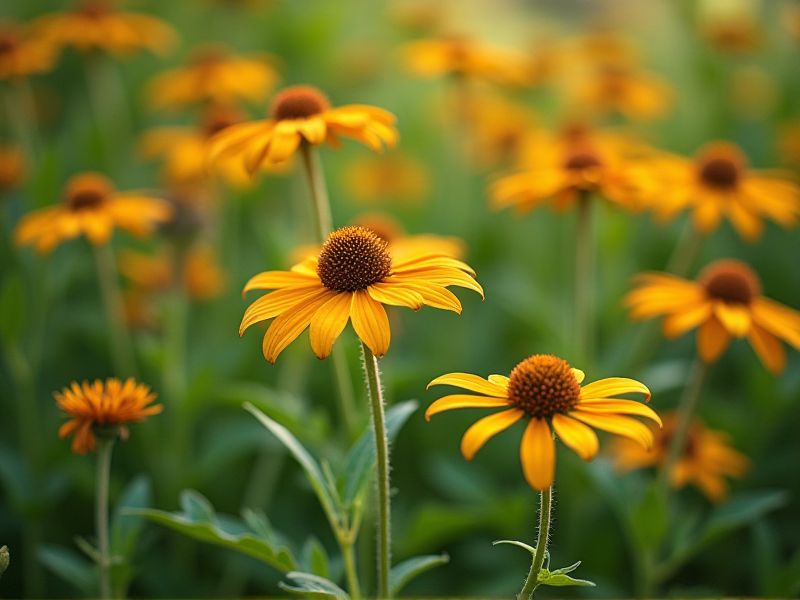
Annual plants that re-seed themselves, often referred to as self-seeding annuals, play a crucial role in sustainable gardening. These plants, such as poppies, sunflowers, and cosmos, complete their life cycle within a single growing season while naturally dispersing seeds. As the flowers fade, they produce seeds that fall to the ground, ensuring new growth in the following year. This process not only reduces the need for replanting but also enhances biodiversity in your garden. Choosing self-seeding annuals helps create a vibrant, low-maintenance landscape that thrives with minimal intervention.
List of some Annual plants that re-seed themselves
- Marigold (Tagetes spp.)
- Nasturtium (Tropaeolum majus)
- Sunflower (Helianthus annuus)
- Cosmos (Cosmos bipinnatus)
- Poppies (Papaver spp.)
- Cleome (Cleome hassleriana)
- Love-in-a-mist (Nigella damascena)
- Calendula (Calendula officinalis)
- Larkspur (Consolida ajacis)
- Sweet Alyssum (Lobularia maritima)
Important things about Annual plants that re-seed themselves
Life Cycle Duration
Annual plants that re-seed themselves have a life cycle that typically spans one growing season, lasting from germination to flowering and seed production. After completing their life cycle, these plants drop seeds into the soil, ensuring their survival and propagation for the next season. Many common annuals, such as cosmos and marigolds, thrive in various conditions, allowing for easy cultivation in gardens. By understanding the life cycle duration and optimal growing conditions, you can plan for vibrant blooms and a self-sustaining garden year after year.
Seed Dispersal Mechanisms
Annual plants that re-seed themselves employ various seed dispersal mechanisms to optimize their growth and reproduction. Wind dispersal is particularly common; lightweight seeds are carried away from the parent plant, allowing colonization of new areas with favorable conditions. Some annuals use animal-mediated dispersal, where seeds attach to fur or are ingested, ensuring distribution far from the source. These strategies enhance genetic diversity and enable survival in fluctuating environments, making them vital players in ecosystem dynamics.
Growth Habitats
Annual plants that re-seed themselves, such as cosmos or zinnias, thrive in diverse environments, making them favorites for gardeners seeking low-maintenance options. These plants complete their life cycle in one growing season, producing seeds that can germinate the following year, ensuring a vibrant display with minimal effort. Ideal for pollinator gardens, they attract bees, butterflies, and other beneficial insects, enhancing the ecological balance. Consider incorporating these self-sowing annuals in your garden to enjoy continuous blooms and promote biodiversity without the need for frequent replanting.
Germination Conditions
Annual plants that re-seed themselves thrive under specific germination conditions that enhance their regenerative capabilities. Optimal soil temperature ranges between 65degF and 75degF facilitate faster sprouting, while consistent moisture levels are crucial to maintaining seed viability. Seeds of such plants often benefit from light exposure; many require light for germination, thus should be sown on the soil surface or lightly covered. Ensuring that your garden space has well-drained, nutrient-rich soil can further support the growth of these self-sowing annuals, promoting a vibrant and sustainable landscape.
Maintenance Requirements
Annual plants that re-seed themselves, such as Cosmos and Zinnias, require minimal maintenance once established. To ensure robust growth, you should provide adequate sunlight and water, especially during dry spells. Periodic deadheading, which involves removing spent flowers, encourages continuous blooming and enhances overall plant health. Additionally, practicing light mulching can suppress weeds and retain soil moisture, allowing your garden to thrive with vibrant self-sowing annuals year after year.
Pest Resistance
Annual plants that re-seed themselves often exhibit remarkable pest resistance traits, allowing them to thrive in various environments. Species like sunflowers and various wildflowers can self-sow, providing a natural defense mechanism by maintaining a continuous population that adapts over time to local pest pressures. By cultivating these resilient plants in your garden, you can create a sustainable ecosystem that reduces the need for chemical pesticides. Understanding the specific diseases and pests associated with your selected annuals can further enhance their pest resistance, promoting healthier growth and increased yield.
Diversity Of Species
Annual plants that re-seed themselves play a crucial role in maintaining biodiversity within ecosystems. Common examples include weeds like lamb's quarters and certain wildflowers, which not only adapt to various environments but also thrive in disturbed soils. These plants produce vast numbers of seeds, enhancing their chances of survival and dispersal, thus contributing to the genetic diversity of plant communities. You can witness firsthand how these self-seeding annuals create vibrant landscapes that support various pollinators and other wildlife, promoting a balanced ecosystem.
Soil Nutrient Needs
Annual plants that re-seed themselves, such as sunflowers and zinnias, benefit significantly from balanced soil nutrient levels to thrive and proliferate. Key macronutrients, including nitrogen, phosphorus, and potassium, are essential for robust growth, abundant blooms, and efficient seed production. Regular soil testing can help you determine nutrient deficiencies and guide your fertilization strategy, ensuring optimal conditions for these self-sowing annuals. Organic matter, such as compost, not only enhances nutrient availability but also improves soil structure, promoting healthy root development and better water retention for future generations of plants.
Climate Adaptability
Annual plants that re-seed themselves, such as wildflowers and certain grains, play a crucial role in climate adaptability by ensuring continuity in diverse ecosystems. These plants complete their life cycle within a single growing season, producing seeds that can germinate the following year under favorable conditions. By this self-sowing mechanism, they contribute to soil health and enhance biodiversity, making them resilient to changing climates. Incorporating these resilient species into your garden not only supports local wildlife but also promotes sustainable agricultural practices.
Impact On Ecosystem
Annual plants that re-seed themselves play a crucial role in maintaining biodiversity and ecosystem stability. By completing their life cycle within a single year, these plants reproduce quickly, ensuring that their genetic material is passed on to the next generation. In diverse habitats, such as grasslands and disturbed areas, they provide essential resources for pollinators and other wildlife. Your garden can benefit from incorporating these resilient species, as they improve soil quality and prevent erosion while creating a vibrant environment for beneficial insects.
